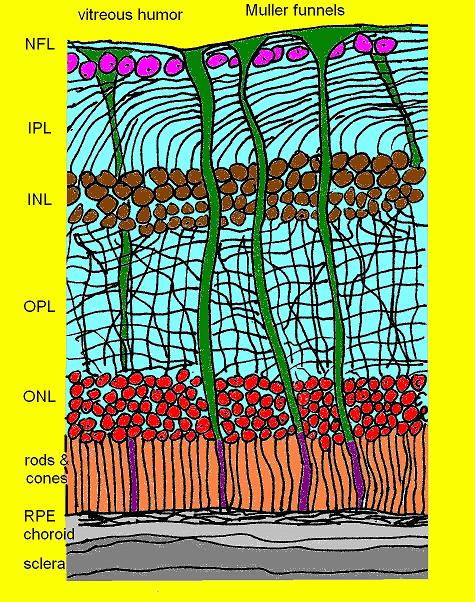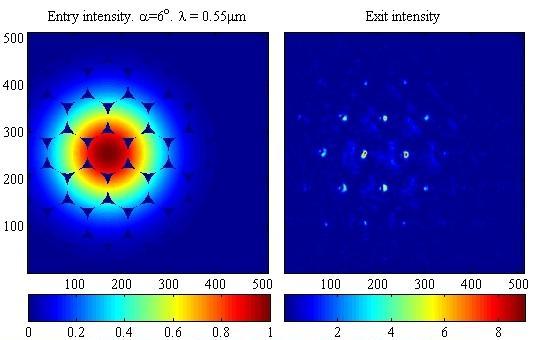"Our eyes are built like a digital camera," explains Professor Erez Ribak from the Faculty of Physics, who solved the mystery with his master's student, Amichai and

The Technion researchers managed to solve a mystery that had occupied scientists for 120 years and found how the structure of the retina helps sharpen vision. In an article published in the scientific journal Physical Review Letters, they describe an optical model of the retina that they built on a computer and through which they transmitted light.
"Our eyes are built like a digital camera," explains Professor Erez Ribak from the Faculty of Physics, who solved the mystery with his master's student, Amichai Deva. "The lens is in front and the detector - the retina - in the back.
On the back side of the retina are the detectors (photocells) covered with transparent layers of neurons (nerve cells). The neurons serve as the wires that process and transmit the image from the detector to the brain, but also distort it.
About three years ago it was discovered that the glial cells, which 'cut' the retina across the layers of neurons, are able to transmit light. We have now built an optical model of the retina and passed light through it.
We discovered that only light coming from the center of the pupil is captured by the glial cells and transmitted directly to the detectors. Light that 'leaks' from nearby cells or comes from the periphery - and which may damage our visual acuity - is reflected and distributed and does not pass to the detectors. This situation would not be possible if the detectors were in front of the neuron layers.


15 תגובות
So cool that they finally found out why...
Really one of the things that bothered me when we learned about it..
I was missing you Bennona=correct :)
I always sat and thought, why actually the human eye does not contain tubes that filter light rays that arrive at the wrong angle, so it turns out that there is.
Response to Michael Rothschild,
"Confess and leave, Yeruham". Apparently I confused the content of your comment with Ariel's.
Regarding the blind spot (BLIND SPOT) - I will clarify my words: the connection is, of course, that these are axons coming from all parts of the retina and draining at the point of the blind spot (ie, the optic disc). But the neuronal layer above the photoreceptors in the rest of the retina does not affect vision, as it is transparent.
In any case, it seems that we are both claiming the same thing, so there is no need to continue the unnecessary bickering.
Kafir:
And read, did you study?
1. You write that the blind spot is an area where the axons are concentrated and at the same time claim that it is not related to the nerves that are above the retina?
Please read what Exxon is: http://en.wikipedia.org/wiki/Axon
2. How did you infer that I believe in intelligent planning?! I'm one of the staunchest defenders of evolution you've ever met!
You would know that if you weren't careful not to read the last line of my response.
Response to Michael Rothschild:
1. The blind spot has nothing to do with the neuronal layer above the photoreceptors. The blind spot is a focused and specific area that is clinically visible as the optic disc. At this point, the axons of the ganglion cells drain from the retina to the lateral nucleus of the thalamus. Since there are no photoreceptors there, a blind spot is created (but such that the brain compensates for its existence through stereoscopic vision and in general in the process of neural integration).
2. There is an enormous amount of scientific evidence that supports the correctness of the theory of evolution. On the other hand, the opponents of the theory jump on every remnant of a virtual crack as the discovery of a lot of loot and see it as scientific proof of God's existence. Of course, this is completely ridiculous, since - from a purely scientific point of view - the incorrectness of theory A does not in itself indicate the correctness of theory B. Therefore, please gather the scientific evidence for the existence of the intelligent designer in which you believe (paradoxical-something, since science is not based on faith) and then we can have a scientific discussion on whether the eye is the result of evolutionary development or of a divine being. Good luck with that 🙂
Gong Man:
It seems to me that the photo is of their model and not of reality.
Nothing in Ein was built "as a parable" for anything else, and of course there is also nothing special about the 6th supplier that justifies a parable about it.
What's more - there are many hexagons in nature and there are various reasons for this.
Honeycombs have hexagons because this is the most efficient way to divide space into cells.
Snowflakes have hexagons because of the structure of the water molecules.
everything has a reason.
In my opinion, the structure of the Star of David is very interesting, especially in light of the fact that it is 6 degrees (as an analogy for 6 ribs)
His lawyer:
As far as I know, Ariel is completely right.
The structure of the eye has always been used to contradict the intelligent design and as another example of the irrational actions of that entity that is supposed to be intelligent and suddenly makes such a mistake and covers the receptors with nerves that partially hide them and create the blind spot.
Now comes the article and claims that this coverage also has a benefit.
Be that as it may, there are several types of eyes in nature, among others, it also has eyes in which the nerves are located at the back and do not hide the receptors.
http://en.wikipedia.org/wiki/Eye#Weaknesses
There is of course enough evidence that disproves intelligent design and there is not a single one that confirms it so you don't need to get excited.
Ariel, you are really confused.
They have always described it as "impossible in evolutionary development", and as proof of intelligent design. Now we see that it makes a lot of evolutionary sense.
To Mr. Ariel's response (4): Human beings (including the commenters...) often use the word "intelligence/intelligent" as a reference to the "great planner" (everything is possible...) and prefer to skip the "earthly reason" called "natural selection" (see Edited by "Charles Darwin!!!…).
That's cool, they always described the layer of neurons on top of the receptors as a design failure and proof against intelligent design. Well, Schwein!
Physicist
It turns out that it is possible.
Anyway, why would the light go back? If he hits at 45 degrees, he returns, changing direction by 90, if he hits at less than that in relation to the surface, why doesn't he continue forward?
Funnels are unable to concentrate light
They are able to concentrate liquids but physically light can never be concentrated using a physical structure of a funnel.
The light compared to a liquid will not be concentrated, it will be partially reflected or absorbed by the structure, but it will not go down concentrated.
Simple optical physics.
On the way to digital artificial eyes?